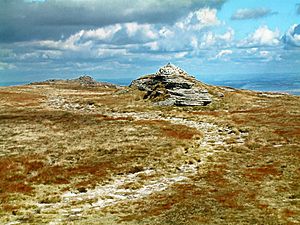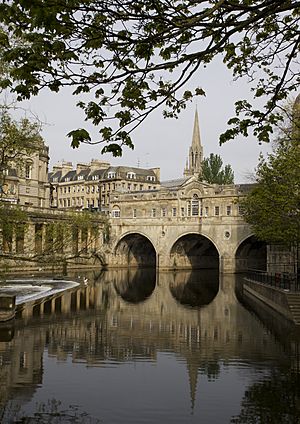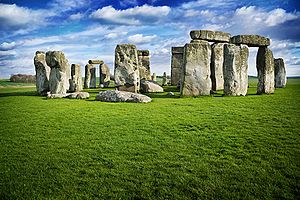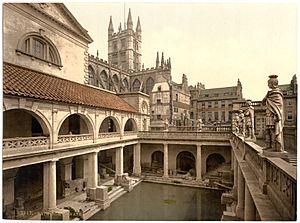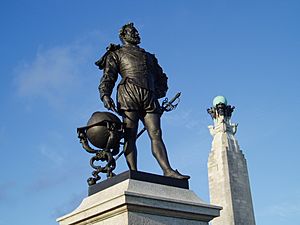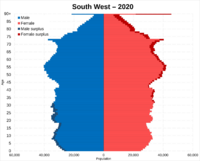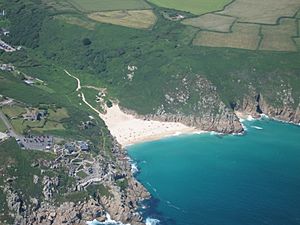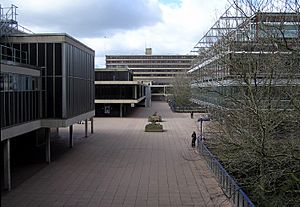South West England facts for kids
Quick facts for kids
South West England
|
|
|---|---|
|
From top, left to right: Clifton Suspension Bridge in Bristol; the Cotswolds; Stonehenge; Newquay; Bath; Dartmoor; Torquay; Durdle Door
|
|
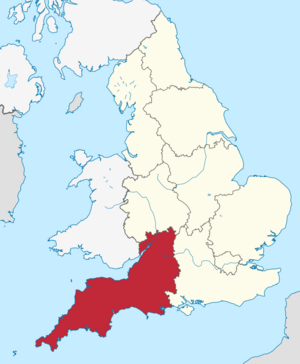
South West England, highlighted in red on a beige political map of England
|
|
| Sovereign state | United Kingdom |
| Country | England |
| Combined authorities | West of England |
| Districts |
|
| Counties | |
| Government | |
| • Type | Local authority leaders' board |
| • Body | South West Councils |
| Area | |
| • Total | 9,415 sq mi (24,386 km2) |
| • Land | 9,203 sq mi (23,836 km2) |
| • Water | 5 sq mi (14 km2) |
| Area rank | 1st |
| Population
(2021)
|
|
| • Total | 5,712,840 |
| • Rank | 6th |
| • Density | 600/sq mi (240/km2) |
| Ethnicity (2021) | |
| • Ethnic groups |
List
|
| Religion (2021) | |
| • Religion |
List
46.2% Christianity
44.1% no religion 1.4% Islam 0.5% Hinduism 0.4% Buddhism 0.1% Sikhism 0.1% Judaism 0.6% other 6.5% not stated |
| GSS code | E12000009 |
| ITL code | TLK |
| GVA | 2021 estimate |
| • Total | £149.8 billion |
| • Rank | 5th |
| • Per capita | £26,219 |
| • Rank | 5th |
| GDP (nominal) | 2021 estimate |
| • Total | £169.3 billion |
| • Rank | 5th |
| • Per capita | £29,628 |
| • Rank | 5th |
South West England is one of the nine official regions in the United Kingdom. It includes the counties of Cornwall, Devon, Dorset, Gloucestershire, Somerset, and Wiltshire. Some of its major cities and towns are Bath, Bristol, Bournemouth, Exeter, Gloucester, Plymouth, and Swindon.
This region is the largest in England by land area, covering about 23,836 square kilometres. It has around 5.7 million people, making it the third least populated region. The South West has the longest coastline of any English region. It's home to two national parks, Dartmoor and Exmoor. It also has four World Heritage Sites: Stonehenge, the Cornwall and West Devon Mining Landscape, the Jurassic Coast, and the City of Bath.
The South West is famous for its rich folklore, like the legend of King Arthur and Glastonbury Tor. It's also known for delicious foods such as Cheddar cheese, Devon cream teas, crabs, Cornish pasties, and cider. You can find the Eden Project here, as well as Aardman Animations (who make Wallace and Gromit!). The region also hosts the Glastonbury Festival and the Bristol International Balloon Fiesta. Many famous writers, like Daphne du Maurier and Agatha Christie, set their stories in this beautiful area.
Contents
Exploring South West England
Land and Nature
Most of South West England is on the South West Peninsula, between the English Channel and Bristol Channel. It has over 700 miles of coastline, which is the longest in England. Much of this coast is protected because it's so important for nature. This makes the region very popular with tourists.
The land is split into two main types. The west, including Cornwall and West Devon, has rocky coastlines and high moorlands like Bodmin Moor and Dartmoor. These areas are made of hard rocks like granite and slate. The highest point in the region is High Willhays on Dartmoor, which is 621 metres tall.
The east of the region has wide, flat clay valleys and hills made of chalk and limestone. These valleys are great for dairy farming. The Somerset Levels were once wetlands but have been reclaimed for farming. The famous Jurassic Coast in Dorset and East Devon shows different rock types from the Mesozoic era, like a giant outdoor geology textbook!
Weather and Climate
The South West has an oceanic climate. This means it has cool winters and warmer summers, with rain throughout the year. It rains more in winter, and up to 2,000 mm on higher ground. Summer temperatures usually range from 18°C to 22°C, and winter temperatures from 1°C to 4°C. It's the second windiest part of the UK. Experts think the region will get warmer in the future.
- Inland areas have less rain and warmer summers. Winters are colder than the coast, and it snows more often.
- Coastal areas have mild winters and slightly cooler summers. They get the least rain and the most sunshine. These areas are also the windiest.
- Moorland areas like Bodmin Moor, Dartmoor, and Exmoor are colder and get twice as much rain as lowland areas. They also have the most snow and the least sunshine.
Identity of the Region
The South West region's borders were first set up in the 1930s for things like civil defence. Some people feel that the region doesn't have a strong shared culture or history because it's so large and diverse. For example, the northern part of Gloucestershire is as far from the tip of Cornwall as it is from the Scottish border!
Many people identify with their local county or town, or as being from the 'West Country'. Cornwall has its own language, Cornish, and some people there feel it should be a separate Celtic nation with its own assembly.
Towns and Cities
The South West is mostly rural, meaning it has many small towns and villages. More people live in these rural areas here than in any other English region. The biggest cities and towns include Bristol, Plymouth, Bournemouth, Poole, Swindon, Torbay, Gloucester, Cheltenham, Exeter, and Bath. The total population of the South West is about 5.7 million.
Getting Around
The South West has several main railway lines. The Great Western main line connects London to Bristol, Exeter, Plymouth, and Penzance in Cornwall. Other lines run from London to Dorset and through Somerset. Most trains are run by South West Trains, Great Western Railway, and CrossCountry.
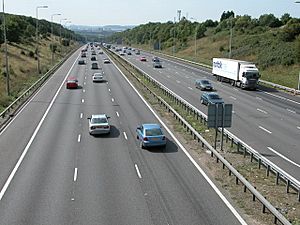
Three main roads enter the region from the east. The M4 motorway goes from London to South Wales through Bristol. The A303 crosses the middle of the region, and the A31 serves Poole and Bournemouth. The M5 motorway runs from the West Midlands through Gloucestershire, Bristol, and Somerset to Exeter. There are also smaller motorways around Bristol.
The main airports in the region are Bristol, Exeter, Newquay, and Bournemouth.
A Look at the Past
Ancient Times
Evidence shows that early humans lived in Somerset about 500,000 years ago. After the last ice age, around 11,000-10,000 BC, people lived in caves at Cheddar Gorge. The oldest complete human skeleton in Britain, called Cheddar Man, lived here around 7150 BC.
During the Neolithic period, people built wooden trackways across the Somerset Levels. The Sweet Track, from around 3900 BC, is thought to be the world's oldest timber trackway. Stonehenge and Avebury in Wiltshire are famous Neolithic sites. The region was very populated during the Stone, Bronze, and Iron Ages, with many ancient monuments.
Roman Times
The Romans were in the South West from AD 47 to about AD 409. The eastern part, like the Cotswolds and eastern Somerset, became very Roman. However, Devon and Cornwall were less Romanised, even though Exeter was a regional capital. You can still see Roman villas, farms, and temples, especially the famous Roman baths in Bath.
The Romans were interested in the lead mines in the Mendip Hills. They built forts at Bath and Ilchester. The Fosse Way, a Roman military road, ran through Bath, Shepton Mallet, and Ilchester. In 2010, the Frome Hoard, one of the largest collections of Roman coins in Britain, was found near Frome.
British Kingdoms and Saxons
After the Romans left, the region was divided into British kingdoms, like Dumnonia (Cornwall, Devon, and parts of Somerset and Dorset). The Anglo-Saxons slowly took control from the east. The Wansdyke was a large ditch built in the 5th or 6th century, probably as a border between the British Celts and the West Saxons.
By the late 7th century, most of Somerset, Dorset, and Devon were under Saxon control. King Alfred the Great later strengthened towns like Exeter to defend against the Vikings. Cornwall remained a British kingdom for longer, eventually becoming part of England around the 9th or 10th century.
The Middle Ages
After the Norman Conquest in 1066, Norman lords controlled the region. Towns like Truro, Totnes, and Okehampton grew, but older cities like Exeter, Bath, and Wells were already very wealthy. This wealth came from sheep farming in the east and tin and silver mining in Devon and Cornwall.
The Black Death arrived in Dorset in 1348 and spread quickly, killing many people. This led to big changes in how farms were run. The Somerset wool industry was one of the biggest in England. Many churches were rebuilt during this time.
Coastal villages and ports, like Fowey and Bristol, relied on fishing and trade. Bristol became a very important port, trading with Ireland and building ships. It was one of England's largest medieval towns after London.
Later History
In the 16th century, there were big changes when King Edward VI introduced a new prayer book. This led to the Prayer Book Rebellion in Cornwall and Devon. The Cornish language began to decline after this time.
During the English Civil War in the 17th century, Somerset mostly supported Parliament, but some areas like Dunster were Royalist. Battles were fought at Lansdowne and Langport. Bristol was also taken by Royalist forces.
In 1685, the Monmouth Rebellion saw rebels from Somerset fight against King James II. They were defeated at the Battle of Sedgemoor, the last battle fought on English soil.
Since the 17th century, Plymouth has grown into a large city, mainly because of its naval base at Devonport. This is now the largest naval base in Western Europe. The 19th century brought better roads, canals, and railways.
During the First World War and Second World War, many soldiers from the South West were killed. Several areas were used as bases for troops preparing for the 1944 D-Day landings. Bristol's city centre was badly damaged by bombing during World War II.
Exmoor became one of Britain's first National Parks in 1954. The Quantock Hills and Mendip Hills were also named Areas of Outstanding Natural Beauty.
How People Live Here
Population and Diversity
In 2021, the South West had a population of over 5.7 million people. It's one of the fastest-growing regions in England. Most people in the region are White British (87.8%), which is higher than the average for England. However, the number of Black and Asian residents has increased.
The South West has the oldest average age in England. For example, West Somerset had an average age of almost 48 in 2011. The region also has the second-highest number of people living in rural areas in the UK.
Languages Spoken
The Cornish language developed from an ancient British language spoken in the area. While it declined over time, it is now being revived.
The local accents and dialects of the South West, often called "West Country" dialects, come from the old West Saxon language spoken by the Anglo-Saxons. These dialects are quite unique and have some influence from Welsh and Cornish.
Economy and Work
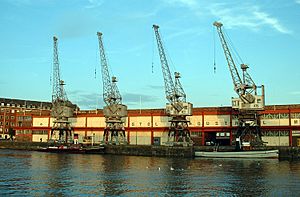
The most active parts of the region's economy are Bristol, the M4 corridor, and south east Dorset. These areas have good connections to London. Bristol alone makes up a quarter of the region's economy.
Bristol's economy was historically based on sea trade, including tobacco and the slave trade. Now, industries like aeronautics (making aircraft parts), defence, telecommunications, and information technology are very important. Companies like Airbus UK and Rolls-Royce have a presence here.
Agriculture is still important in many parts of the region, especially dairy farming in Dorset and Devon. The South West has more cattle and grassland than most other regions.
Tourism is a huge part of the economy. In 2003, tourism brought in almost £5 billion to the region. There are many hotels and places for visitors to stay.
There are big differences in wealth across the region. Bristol is one of the richest cities in England, but some parts of Cornwall have very low average incomes. Cornwall's economy relies heavily on tourism, but it also has companies like Imerys (kaolin producers) and Rodda's (clotted cream).
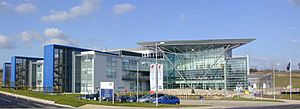
In Devon, the Met Office (which forecasts weather) is in Exeter. Other companies include Pennon Group (water company) and Pedigree Dolls & Toys (who make Sindy dolls). Appledore Shipbuilders build parts for large ships.
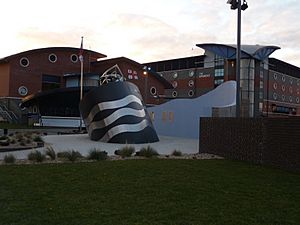
Dorset is home to New Look (clothing), Wytch Farm (the UK's largest onshore oil field), and Meggitt (aerospace and defence). The Royal National Lifeboat Institution (RNLI) has its headquarters in Poole.

Gloucestershire's biggest employer is GCHQ, an intelligence agency. Other companies include Kohler Mira Ltd (showers) and Superdry (clothing). GE Aviation Systems UK makes flight control systems.
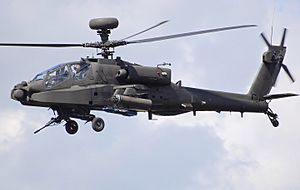
In Somerset, Screwfix and Clarks shoes are based in Yeovil and Street. Shepton Mallet is known for cider. Leonardo makes helicopters in Yeovil, and Numatic International Limited makes vacuum cleaners in Chard.
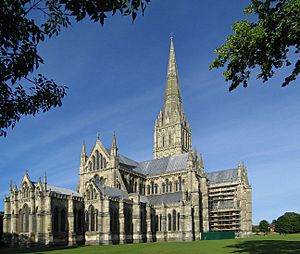
Wiltshire is home to Nationwide Building Society and Intel Europe in Swindon. BMW presses metal for the Mini car here, and Honda has a large car manufacturing plant. Dyson (known for vacuum cleaners) is based in Malmesbury.
Learning in the South West
Schools and Colleges
The South West has a slightly lower rate of good GCSE results compared to the national average. However, it performs well in A-Level exams. There are around 29 colleges for further education in the region.
Universities
The South West has twelve universities, including:
- Arts University Bournemouth
- Bournemouth University
- Bath Spa University
- University of Bath
- University of Bristol
- University of Exeter
- Falmouth University
- University of Gloucestershire
- University of Plymouth
- Plymouth Marjon University
- Royal Agricultural University
- University of the West of England (UWE)
Many students from the South West choose to stay in the region for university. Others often go to universities in the South East of England. After graduating, about half of students find jobs within the South West.
Media and Sport
Local Media
The South West has its own TV news programmes, like Spotlight (BBC South West) and Points West (BBC West). There are also local BBC radio stations for each county, such as BBC Radio Cornwall and BBC Radio Devon.
Many commercial radio stations operate in the region, including Heart West and Greatest Hits Radio South West. Local newspapers include the Bristol Post, Western Morning News, and Dorset Echo.
Sports Teams
In rugby union, the South West has four teams in the top league, Premiership Rugby: Bath Rugby, Bristol Bears, Exeter Chiefs, and Gloucester Rugby.
In football, the region has several teams in the English Football League, such as Bristol City, Bristol Rovers, Exeter City, and Plymouth Argyle.
Images for kids
-
Durdle Door in Dorset is part of the Jurassic Coast, England's only natural World Heritage Site.
-
Dairy Crest have their main cheese creamery in Davidstow making Cathedral City Cheddar and Davidstow Cheddar on the former RAF Davidstow Moor, and important wartime RAF Coastal Command airfield bought by Cow & Gate in the 1950s
-
Ginsters have a food production plant in Callington, off the A390 between Liskeard and Tavistock
-
Cobham underwing refuelling pod on an RAF Voyager, or Airbus A330 MRTT (the aircraft is made at CASA, part of Airbus Defence and Space, in Getafe in central Spain)
-
Safran Landing Systems UK (former Messier-Dowty, historically Britain's main aircraft undercarriage manufacturer, now owned by Safran) make undercarriage for Boeing aircraft; the South West region has the most aerospace industry in the UK (followed by the North West, which has Warton and Samlesbury)
-
Mendip Vale the nearest station to the city of Wells which is cut off from the rest of the UK by the Beeching cuts.
-
Former brandy butter plant at Chard Junction next to the River Axe
-
Shredded Wheat factory at Staverton north of Trowbridge
See also
 In Spanish: Región del Sudoeste de Inglaterra para niños
In Spanish: Región del Sudoeste de Inglaterra para niños










